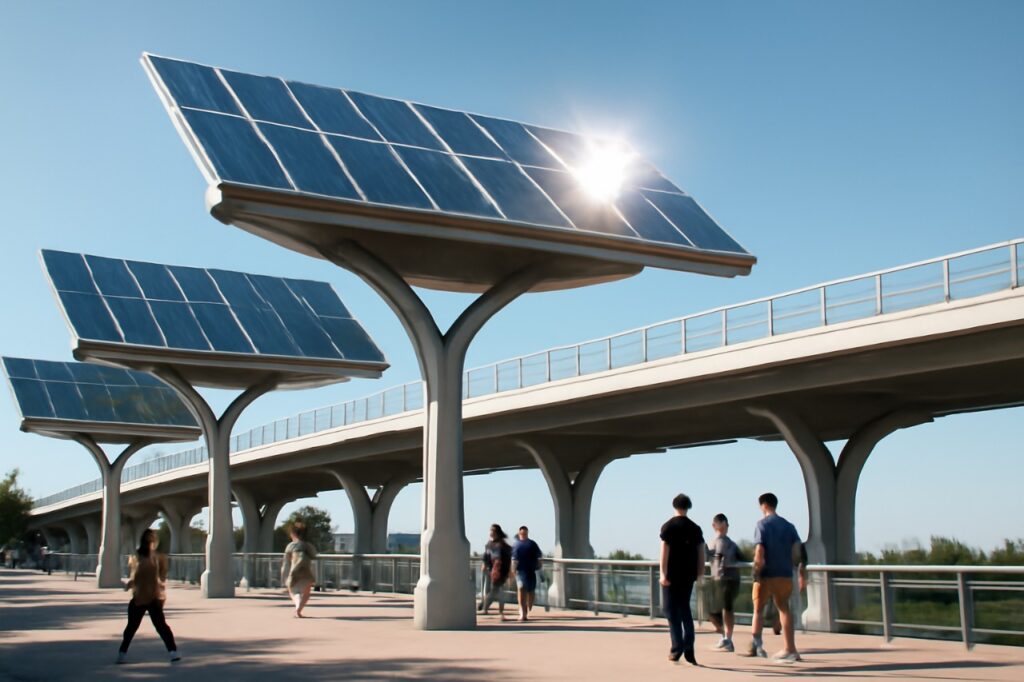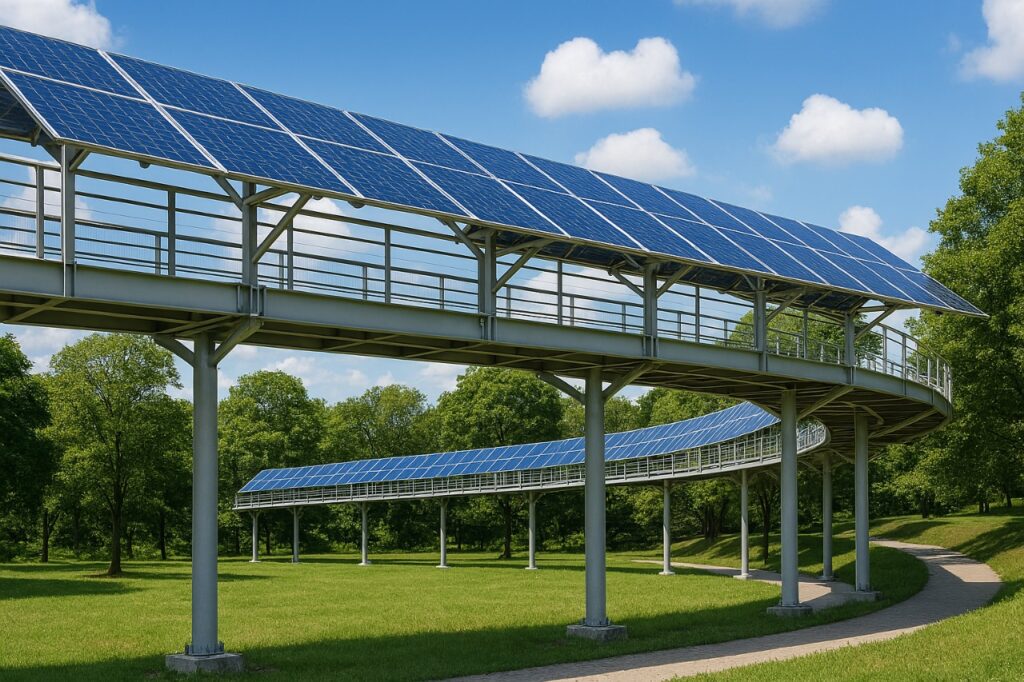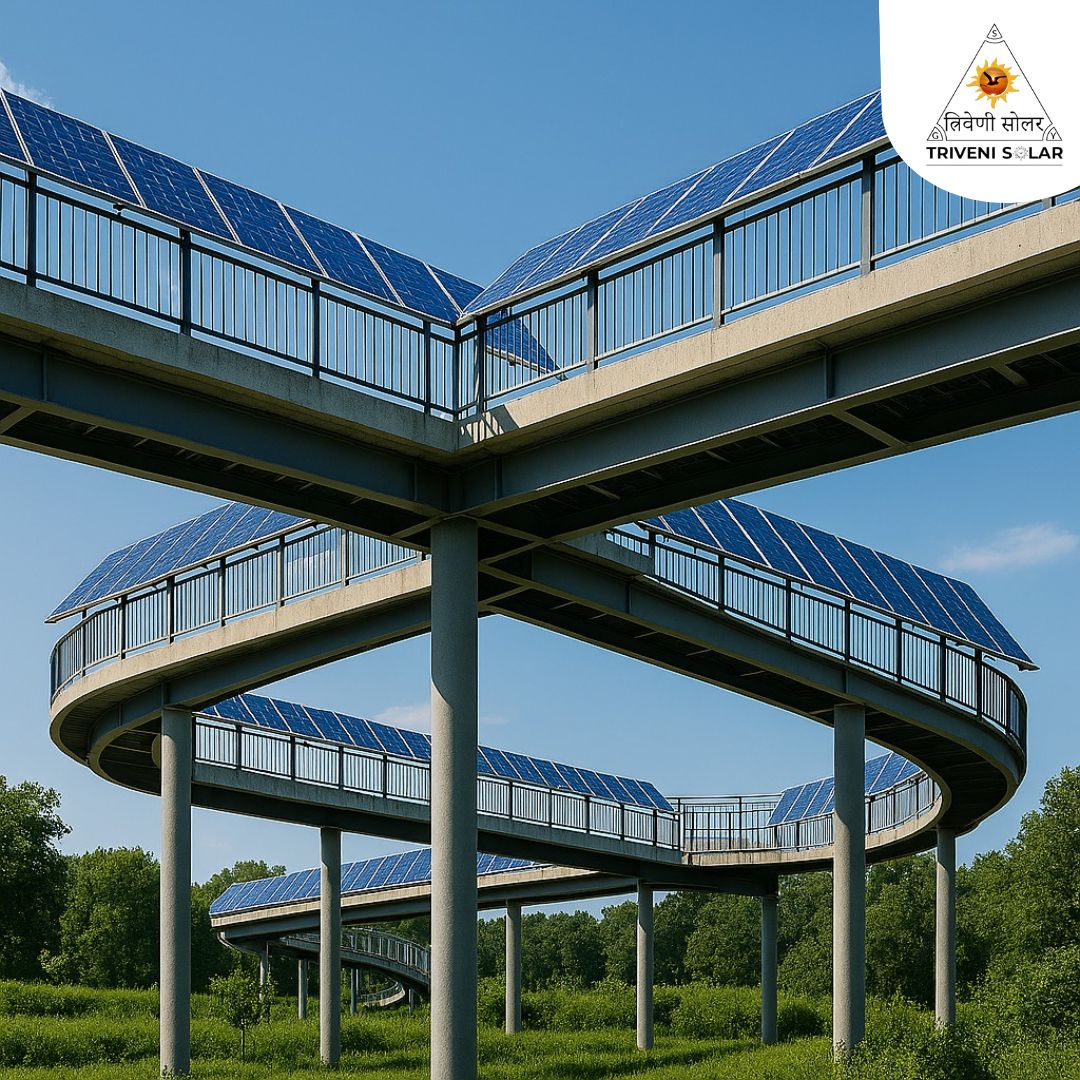Elevated walkway structures are raised platforms designed to provide safe pedestrian access in industrial, solar, commercial, and public spaces. Built from durable materials like steel or FRP, they enhance safety, optimize space, and ensure long-lasting performance under varying load and weather conditions.
What Are Elevated Walkway Structures?
An elevated walkway structure is a raised pathway, typically constructed from steel, aluminum, or fiber-reinforced polymer (FRP), that allows pedestrians to safely move across areas where ground-level access is either unsafe, restricted, or inefficient. Unlike conventional walkways, these are designed to withstand heavy foot traffic, harsh weather, and industrial loads while maintaining high safety standards.
These walkways are modular, customizable, and versatile, making them a preferred choice for solar plants, factories, warehouses, airports, commercial complexes, and smart cities. They not only improve operational safety but also ensure better space utilization, especially in environments where equipment, pipelines, or solar installations occupy ground level.
Why Choose Elevated Walkway Structures?
Investing in elevated walkway structures provides long-term value, safety, and compliance. Here are the top reasons industries, businesses, and public authorities rely on them:
✅ Safety & Accessibility
- Provides secure pedestrian access in hazardous areas.
- Prevents accidents in sites with machinery, pipelines, or solar installations.
- Meets international safety standards (OSHA/ISO), reducing liability risks.
✅ Space Optimization
- Frees up ground-level space for machinery, vehicles, or solar panels.
- Multi-level structures improve site layout efficiency.
- Enables vertical space utilization in dense industrial or urban areas.
✅ Durability & Longevity
- Constructed from hot-dip galvanized steel, powder-coated aluminum, or corrosion-resistant FRP.
- Withstands extreme weather conditions, including heat, humidity, and heavy rainfall.
- Life expectancy often exceeds 25–30 years with minimal maintenance.
✅ Sustainability
- Eco-friendly designs using recyclable metals and sustainable coatings.
- Often integrated with solar panel mounting structures to support green energy projects.
- Reduced carbon footprint compared to temporary or conventional access methods.
✅ Aesthetic & Functional Appeal
- Available in modern, modular designs that complement corporate and public infrastructure.
- Can be customized with canopies, lighting, handrails, and non-slip flooring.
- Blends safety with visual appeal for malls, airports, hospitals, and smart cities.

Elevated Walkway Structures Technical Specifications & Material Choices
The performance of elevated walkway structures depends largely on their materials and design engineering. At SolarStructure.co.in, every walkway is engineered with precision, compliance, and durability in mind.
Common Materials Used:
- Hot-Dip Galvanized Steel → Superior strength, excellent corrosion resistance, cost-effective.
- Aluminum Alloys → Lightweight, rust-free, suitable for humid or coastal areas.
- FRP (Fiber Reinforced Polymer) → Non-conductive, chemical-resistant, perfect for power plants and hazardous industries.
Finishes & Coatings:
- Powder Coating → Enhanced aesthetics + weather protection.
- Epoxy Paints → Chemical resistance in industrial settings.
- Hot-Dip Galvanization → 40+ years of rust protection.
Load Capacity & Safety Features:
- Designed to support heavy foot traffic & equipment access.
- Integrated anti-slip gratings and safety rails.
- Complies with OSHA & ISO safety standards.
📊 Comparison Table: Steel vs. Aluminum vs. FRP Walkway Structures
| Feature | Steel | Aluminium | FRP (Fiber-Reinforced Polymer) |
|---|---|---|---|
| Strength | ★★★★★ | ★★★★☆ | ★★★☆☆ |
| Weight | Heavy | Lightweight | Ultra-Light |
| Corrosion Resistance | Medium (requires coating) | High | Very High |
| Cost | Affordable | Moderate | Higher |
| Lifespan | 25–30 years | 20–25 years | 15–20 years |
| Applications | Industrial, Solar, Heavy Duty | Coastal, Airports, Commercial | Hazardous, Chemical Plants |

Applications of Elevated Walkway Structures
Elevated walkway structures have multi-industry applications, making them one of the most versatile infrastructure solutions:
1. Solar Power Plants
- Used for safe technician movement above solar panels.
- Ensures maintenance access without shading panels.
- Prevents ground-level obstruction in solar farms.
2. Industrial & Manufacturing Plants
- Allows workers to move safely over machinery and pipelines.
- Reduces downtime during maintenance operations.
- Enhances workplace safety & compliance.
3. Warehouses & Logistics Hubs
- Provides multi-level access in storage and dispatch areas.
- Ideal for inventory management & monitoring equipment.
4. Public Infrastructure
- Used in airports, metro stations, and bus terminals for pedestrian safety.
- Facilitates crowd management in high-traffic areas.
5. Commercial Complexes & Smart Cities
- Enhances accessibility in malls, hospitals, and universities.
- Adds an aesthetic yet functional element to modern city planning.
🔗 Conclusion:
Looking for a durable, customizable, and safe elevated walkway solution for your project? Get in touch with Solar Structure Co. today for expert consultation and a free quote.


